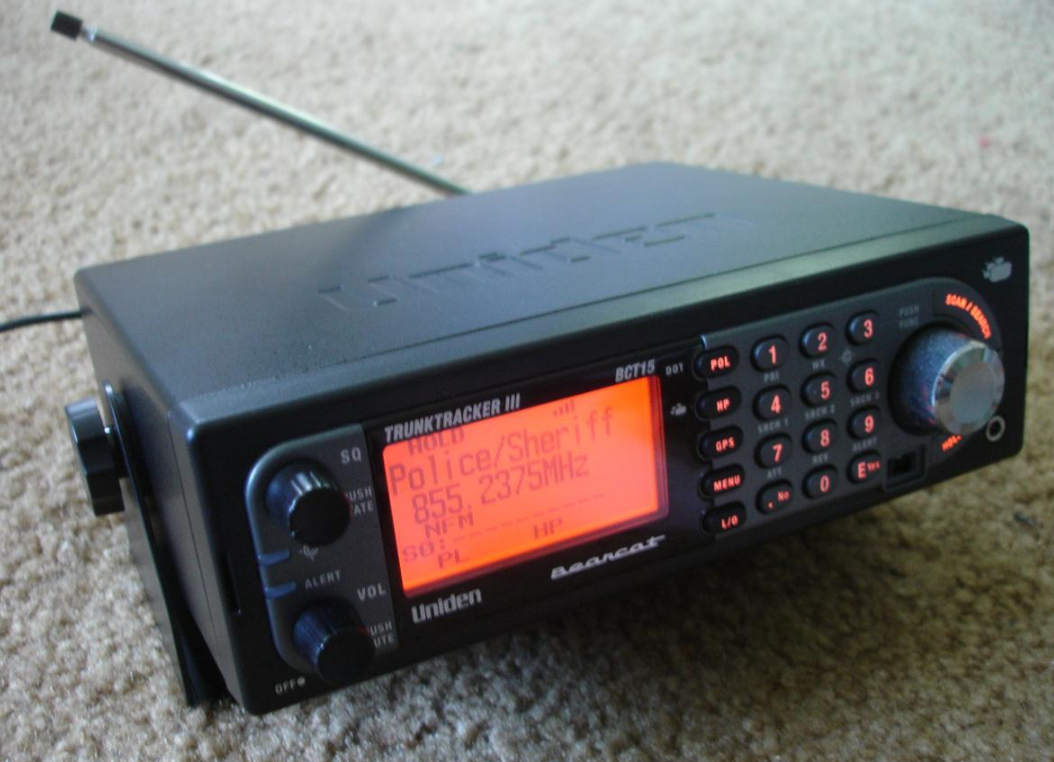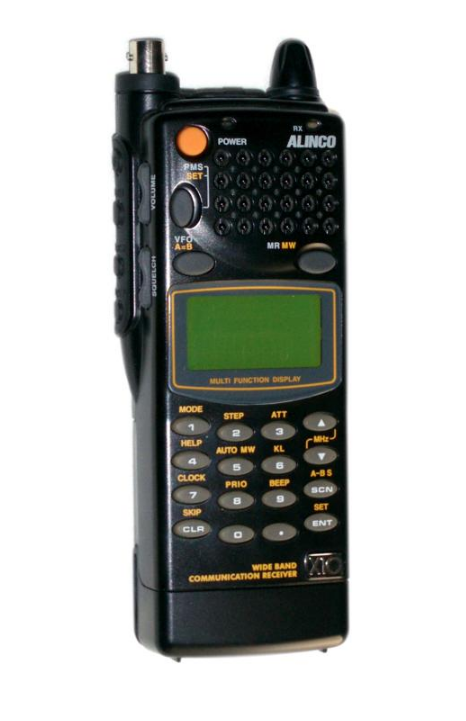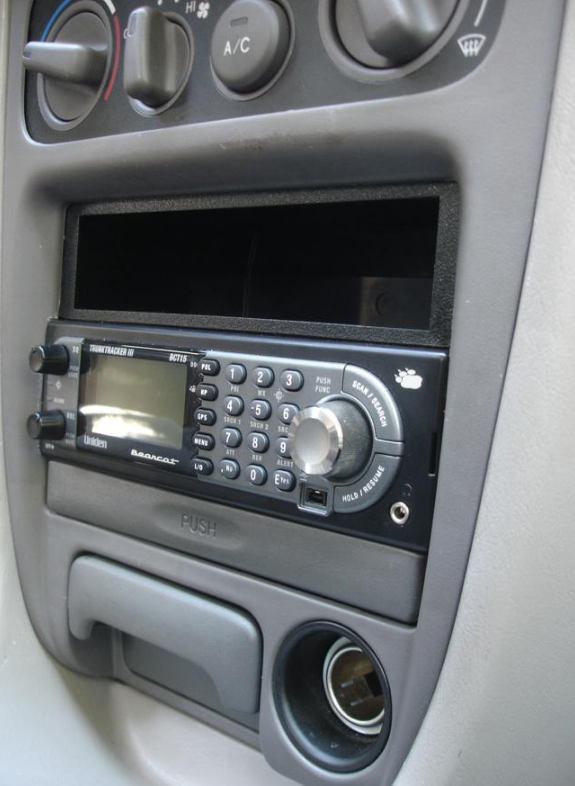A scanner (also referred to a police scanner, police scanner radio or radio scanner) is a radio receiver that can automatically tune, or scan, two or more discrete frequencies, stopping when it finds a signal on one of them and then continuing to scan other frequencies when the initial transmission ceases. The terms radio scanner or police scanner generally refer to a communications receiver that is primarily intended for monitoring VHF and UHF landmobile radio systems, as opposed to, for instance, a receiver used to monitor international shortwave transmissions. More often than not, these scanners can also tune to different types of modulation as well (AM, FM, WFM, etc.). Early scanners were slow, bulky, and expensive. Today, modern microprocessors have enabled scanners to store thousands of channels and monitor hundreds of channels per second. Recent models can follow trunked radio systems and decode APCO-P25 digital transmissions. Both hand held and desktop models are available. Scanners are often used to monitor police, fire and emergency medical services. Radio scanning serves an important role in the fields of journalism and crime investigation, as well as a hobby for many people around the world.
- radio receiver
- modern microprocessors
- medical
1. History and Use
Scanners developed from earlier tunable and fixed-frequency radios that received one frequency at a time. Non-broadcast radio systems, such as those used by public safety agencies, do not transmit continuously. With a radio fixed on a single frequency, much time could pass between transmissions, while other frequencies might be active. A scanning radio will sequentially monitor multiple programmed channels, or search between user defined frequency limits. The scanner will stop on an active frequency strong enough to break the radio's squelch setting and resume scanning other frequencies when that activity ceases.
Scanners first became popular and widely available during the heyday of CB radio in the 1970s. The first scanners often had between four and ten channels and required the purchase of a separate crystal for each frequency received. A US patent was issued to Peter W. Pflasterer on June 1, 1976. An early 1976 US entry was the Tennelec MCP-1, sold at the January 1976 Consumer Electronics Show in Chicago.[1]
2. Features

Many recent models will allow scanning of the specific DCS or CTCSS code used on a specific frequency should it have multiple users. One memory bank can be assigned to air traffic control, another can be for local marine communications, and yet another for local police frequencies. These can be switched on and off depending on the user's preference. Most scanners have a weather radio band, allowing the listener to tune into weather radio broadcasts from a NOAA transmitter.
Some scanners are equipped with Fire-Tone out. Fire tone out decodes Quick Call type tones and acts as a pager when the correct sequence of tones is detected.
Modern scanners allow hundreds or thousands of frequencies to be entered via a keypad and stored in various 'memory banks' and can scan at a rapid rate due to modern microprocessors.
Active frequencies can be found by searching the internet and frequency reference books[2] or can be discovered through a programmable scanner's search function. An external antenna for a desktop scanner or an extendable antenna for a hand held unit will provide greater performance than the original equipment antennas provided by manufacturers.
3. Uses

Scanners are used by hobbyists, railfans, auto race fans, aviation enthusiasts, off duty emergency services personnel, reporters.
Many scanner clubs exist to allow members to share information about frequencies, codes and operations. Most have Internet presence, such as websites, email lists or Web forums.
4. Legislation

4.1. Australia
It is legal to possess a scanner in Australia. It is legal to listen to any transmission that is not classified as telecommunication (i.e. anything not connected to the telephone network).
4.2. Italy
Owning a scanner that is able to intercept the frequencies of law enforcement, is illegal and carries a jail sentence from one to five years. Art. 617 bis Civil Penal Code. [3]
4.3. Japan
It is legal to possess, install and operate a scanner in Japan. The radio law prohibits from disclosing or passing on information received to other persons and using the information to gain personal profit. It is illegal to listen to telephone communication and those transmitted using tapping devices. An amateur radio license is required when amateur radio apparatus is used to listen to radio.
4.4. New Zealand
In New Zealand, according to the Radiocommunications Act 1989[4] it is legal to possess and use a scanner at any time to tune to any private voice radio (not encrypted data) provided that private information is not passed on or disclosed to any other person(s) or party(s).
4.5. United Kingdom
In the UK it is not illegal to own or use a scanner except in particular circumstances. For example, particular transmissions or frequencies should only be listened to with authorization an example of this being UK aviation frequencies, which in many other countries may be publicly listened (and are even available to be streamed online[5]) to but in the UK are restricted.[6]
4.6. North America
The legality of radio scanners varies considerably between jurisdictions. In the United States it is a federal crime to monitor cellular phone calls. Five US states restrict the use of a scanner in an automobile.[7] Although scanners capable of following trunked radio systems and demodulating some digital radio systems such as APCO Project 25 are available, decryption-capable scanners would be a violation of United States law and possibly laws of other countries.
A law passed by the Congress of the United States, under the pressure from cellular telephone interests, prohibited scanners sold after a certain date from receiving frequencies allocated to the Cellular Radio Service. The law was later amended to make it illegal to modify radios to receive those frequencies, and also to sell radios that could be easily modified to do so.[8] This law remains in effect even though few cellular subscribers still use analog technology. There are Canada and European unblocked versions available, but these are illegal to import into the U.S. Frequencies used by early cordless phones at 43.720–44.480 MHz, 46.610–46.930 MHz, and 902.000–906.000 MHz can be picked up by many scanners. The proliferation of scanners led most cordless phone manufacturers to produce cordless handsets operating on a more secure 2.4 GHz system using spread-spectrum technology. Certain states in the United States such as New York and Florida, prohibit the use of scanners in a vehicle unless the operator has a radio license issued from the Federal Communications Commission (FCC) (Amateur Radio, etc.)[9][10] or the operator's job requires the use of a scanner in a vehicle (e.g., police, fire, utilities).
In some parts of the United States, there are extra penalties for the possession of a scanner during a crime, and some states, such as Michigan, also prohibit the possession of a scanner by a person who has been convicted of a felony in the last five years.[11]
In the United States, Licensed Amateur Radio Operators with a valid FCC License may possess Amateur Radio Transceivers capable of reception beyond the Amateur Radio Bands per an FCC Memorandum & Order known as FCC Docket PR91-36 (also known as FCC 93-410).[12][13]
In Canada , according to the Radiocommunication Act,[14] it is completely legal to install, operate or possess a radio apparatus that is capable only of the reception of broadcasting (digital and analogue, but not encrypted data) provided that private information is not passed on or disclosed to any other person(s) or party(s).
A situation that occurred in the Toronto area on 28 June 2011 involving York Regional Police officer Constable Garrett Styles was picked up by scanners. On-line streaming of communications between the officer and police dispatch while the fatally injured officer was in urgent need of emergency help were picked up by local media. The tragedy was widely reported before the officer's family was notified. Several media outlets rebroadcast the recorded emergency transmission. A police initiative pressuring the government to create legislation to stop online streaming of scanner captured police communications was announced in April 2012.[15] Although it is currently legal to stream information from a scanner in Canada, using the information for profit is not legal. Some Canadian police forces use encrypted communications which cannot legally be unencrypted and streamed onto the Internet. Applications are available permitting anyone with an Internet ready computer or smart phone to access scanner communications that are streamed onto the Internet by private individuals who possess the appropriate scanner and computer equipment.
In Mexico it is legal to have an unblocked scanner and listen to any radio spectrum frequencies including encrypted and cellular band. According to the Federal Law of General Ways of Communication, individuals are prohibited from spreading any information obtained via the mass media.[16]
4.7. South America
In Brazil it is legal to have a scanner, but the user should have a ham radio license. Individuals are prohibited from spreading or recording any information obtained.
4.8. Netherlands
In the Netherlands it is legal to listen to any radio spectrum frequency because of the "freedom of information"-doctrine However, if a "special" (i.e., unusual) effort is needed to intercept the information on a frequency (such as decrypting encrypted traffic or using an unauthorized scanner) then it is considered illegal.[17] In 2008, the Dutch Supreme Court ruled that receivers that can solely be used to detect certain frequencies (such as radar detectors) are illegal because they cannot be used to "convey knowledge or thoughts" and thus are not covered by the aforementioned doctrine.[18]
The content is sourced from: https://handwiki.org/wiki/Engineering:Scanner_(radio)
References
- Curtis, Anthony R. (July 1977). "Computerized scanners". Popular Mechanics 148 (1): 68–70. https://books.google.com/books?id=tOIDAAAAMBAJ&pg=PA70. Retrieved 1 June 2011.
- Kneitel, Tom (1986). The "Top Secret" registry of U.S. Government radio frequencies. Commack, NY: CRB Research. ISBN 0-939780-06-2.
- "Art. 617 bis codice penale - Installazione di apparecchiature atte ad intercettare od impedire comunicazioni o conversazioni telegrafiche o telefoniche". http://www.brocardi.it/codice-penale/libro-secondo/titolo-xii/capo-iii/sezione-v/art617bis.html. Retrieved 22 September 2018.
- "Radiocommunications Act 1989 No 148 (as at 28 September 2017), Public Act Contents – New Zealand Legislation". http://www.legislation.govt.nz/act/public/1989/0148/latest/DLM195576.html. Retrieved 22 September 2018.
- "Listen to Live ATC (Air Traffic Control) Communications - LiveATC.net". http://www.liveatc.net/. Retrieved 22 September 2018.
- "The law regarding listening to UK air traffic. - Heathrow Airport Information". 12 April 2011. http://www.heathrow-london.co.uk/airport/plane-spotters/the-law-regarding-listening-to-uk-air-traffic. Retrieved 22 September 2018.
- "Are Police Scanners Legal? Police Scanner Laws in the U.S.". http://www.zipscanners.com/resources/are-police-scanners-legal. Retrieved 22 September 2018.
- FCC (1997-07-10). DA 97-1440: Manufacturing Illegal Scanners Includes Scanner Modification. Federal Communications Commission, 10 July 1997. Retrieved from http://www.fcc.gov/Bureaus/Engineering_Technology/Public_Notices/1997/da971440.txt.
- §397 Equipping motor vehicles with radio receiving sets http://public.leginfo.state.ny.us/lawssrch.cgi?NVLWO:
- "Statutes & Constitution :View Statutes : Online Sunshine". http://www.leg.state.fl.us/Statutes/index.cfm?App_mode=Display_Statute&Search_String=&URL=0800-0899/0843/Sections/0843.16.html. Retrieved 22 September 2018.
- "Michigan Legislature - Section 750.508". http://legislature.mi.gov/doc.aspx?mcl-750-508. Retrieved 22 September 2018.
- FCC (1993-09-03). PR Docket 91-36: In the Matter of Federal Preemption of State and Local Laws Concerning Amateur Operator Use of Transceivers Capable of Reception Beyond Amateur Service Frequency Allocations—Memorandum Opinion and Order. Federal Communications Commission, 3 September 1993. Retrieved from http://www.arrl.org/files/file/pr91-36.pdf.
- A partial copy of the Electronic Communications Privacy Act of 1986 can be found at http://floridalawfirm.com/privacy.html with the following disclaimer: "This document was originally published by Florida Law Firm in 1998. It is no longer current and should not be relied upon for any reason."
- Radiocommunication Act: An Act respecting radiocommunication in Canada. R.S., 1985, c. R-2, s. 1; 1989, c. 17, s. 2. http://laws.justice.gc.ca/PDF/Statute/R/R-2.pdf
- Gonczol, David (13 April 2012). "Police Hope to End Rebroadcasting of Scanners". Ottawa Citizen. https://ottawacitizen.com/news/Police+hope+rebroadcasting+scanners/6457392/story.html. Retrieved 14 April 2012.
- "Ley de Vías Generales de Comunicación - 73". http://www.diputados.gob.mx/LeyesBiblio/pdf/73.pdf.
- "Vrije signalen uit de ether - ICTRecht juridisch adviesbureau". https://ictrecht.nl/juridisch-advies/vrije-signalen-uit-de-ether/. Retrieved 22 September 2018.
- Raad, Parket bij de Hoge (8 April 2008). "ECLI:NL:PHR:2008:BC4284, voorheen LJN BC4284, Parket bij de Hoge Raad, 03362/06". https://uitspraken.rechtspraak.nl/inziendocument?id=ECLI:NL:PHR:2008:BC4284. Retrieved 22 September 2018.
